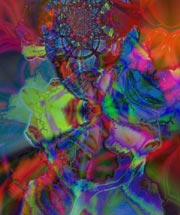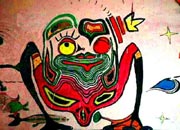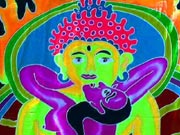 |
Goans love music that spans from Portuguese music to Techno,
Rave and the land's very own Goa Trance. Locals love to
hear Konkani, Hindi and English, occasionally with a little
Portuguese music thrown in for good measure. The energetic
DJs love to ramble on between each piece of music, which
is a low point of the orchestras here. Goans is a land of
singers and dramatists such as Prince Jacob, Kid Boxer,
Emiliano D'cruz, Alfred Rose, Tony King, Souza Boy, M. Boyer,
Rosario Rodrigues and J. B. Rod. 'Tiatre' (Konkani theatre)
forms the base of many of the music pieces. There are 'Tiartists'
who produce plays with political satire such as the famous
William de Curtorim. Love, family melodramas and artist's
interpretation of life are some of the popular themes here.
It is said that Goans are born with music in their blood
as the rustic Dhangar (shepherd) plays his flutes to pass
his time in the countryside or the more sophisticated city
people tune up their tabla, sitar, violin or piano in concert
halls. Goan folk music has a lively rhythm and the rugged
vitality of its folk-dances is enhanced by the musical instruments
such as Ghumats, Dhols, Cymbals (Drums), Flutes, Harmonium,
Violins and Guitars. The dynamic folk art forms of Goa are
known for their rhythmic charm, emotional content, colorful
variety and vitality. Some of the well renowned folk arts
of Goa include Khell-Tiatro and Jagar-perani.
|
| a is often admired as a nest of singing birds.
The tiny land of Goa speaks with the pleasing and harmonious
note of varied music and melody. Music is part of life at Goa.
Through out the year, Ghumat and Violin are at their forefront
to be part of every gala event. Every Goan folk music has a
lively rhythmic vitality. The music has devotional as well as
profane overtones. Goan music stands apart from the music of
other regions in India because of its peculiar blend of Western
and Indian traditions.
The taste of the west can be found in the music of Goa too.
The music and dance of Goa are a rich cultural blend of the
West with the East. The fine blend of Indian classical and
western music has discovered many different forms of music.
Each occasion and region has its distinctive forms. The urban
areas have adapted to modern and popular music styles. |
Forms of Music in Goa
Mando - the love song
Mando is love song, sung by Goan Catholics in group accompanied
with dance. A group of boys and girls, some 20 in number, form
a semi-circular pattern in two lines with the girls in the front
line and the boys in the back line. The songs cover the entire
gamut of emotions in love, accompanied by the beats of Ghumat
and romantic strains of violin.
Mando - the Latin Taste
Set to the Latin American tune, the song with a local theme
starts with a sad and slow note and ends on a faster beat
called "Dulpods" or "Durpodha", the rhythmic
pattern being akin to 'Khaiyal' songs. In fact Mando represents
the mingling of Indian and Western traditions. The girls and
the boys sing a line of the song one after the other or sometimes
in chorus.
Suvari - the Folk Music
Suvari is a traditional folk music, a tone setter to all Hindu
religious and festival performances. The music is orchestral
in nature and relies heavily on 'Laya' (tune) and 'Tal' (beat),
as spoken words are few. The orchestra consists of 'Ghumat',
'Shamel', Cymbals and sometimes 'Shehnai' and 'Surt'.
Other forms of Goan music include "Banvad", "Cantaram",
"Dasra Vadan", "Gadya Ramayan", "Gaun
Kani", "Gosavi Gayan", "Gudulya Geetam",
"Jat", "Lagan Geet", "Lavni",
"Pavada", and devotional music like "Bhajan-Dindi",
Carol Singing, "Kirtan" and "Ladainha". |
| Goa Trance |
 Goa
trance is form of electronic music and is a style of trance
music which originated in the Indian region of Goa. The music
has its roots in the popularity of the Goa region in the late
1960's and early 1970's as a hippie mecca, although the actual
Goa trance style would not appear until much later. As the
tourist influx tapered off in the 1970's and 1980's, a core
group remained in Goa, concentrating on improvements in music
along with other activities such as yoga, recreational drug
use, and various New Age pursuits. Goa
trance is form of electronic music and is a style of trance
music which originated in the Indian region of Goa. The music
has its roots in the popularity of the Goa region in the late
1960's and early 1970's as a hippie mecca, although the actual
Goa trance style would not appear until much later. As the
tourist influx tapered off in the 1970's and 1980's, a core
group remained in Goa, concentrating on improvements in music
along with other activities such as yoga, recreational drug
use, and various New Age pursuits.
The introduction of techno style and technique
to Goa led to what would eventually become the Goa trance
style; early pioneers included Goa Gil and Mark Allen. Many
"parties" (similar to raves) in Goa revolve entirely
around this genre of music; Goa is also often played in other
countries at raves, festivals and parties often in conjunction
with other styles of trance and techno.
 Goa
is essentially "dance-trance" music (and was referred
to as "Trance Dance" in its formative years), and
as such has an energetic beat, almost always at 4/4 and often
going into 16th or 32nd notes. A typical number will generally
build up to a much more energetic movement in the second half
of the track, and then taper off fairly quickly toward the
end. Generally 8-12 minutes long, Goa tracks usually have
a noticeably stronger bassline than other trance music and
incorporate more organic "squelchy" sounds. Goa
is essentially "dance-trance" music (and was referred
to as "Trance Dance" in its formative years), and
as such has an energetic beat, almost always at 4/4 and often
going into 16th or 32nd notes. A typical number will generally
build up to a much more energetic movement in the second half
of the track, and then taper off fairly quickly toward the
end. Generally 8-12 minutes long, Goa tracks usually have
a noticeably stronger bassline than other trance music and
incorporate more organic "squelchy" sounds.
 Goa
trance parties have a visual aspect as well, the use of "fluoro"
(fluorescent paint) is common in clothing and decoration.
The images are often associate with topics like aliens, hinduism
and other religious (especially eastern) images, mushrooms
(and other psychedelic imagery), shamanism and technology.
Goa trance has a significant following in Israel, brought
to that country by former soldiers returning from recreational
"post-army trips" to Goa. A great deal of Goa trance
is now produced in Israel, but its production and consumption
is a global phenomenon. Goa
trance parties have a visual aspect as well, the use of "fluoro"
(fluorescent paint) is common in clothing and decoration.
The images are often associate with topics like aliens, hinduism
and other religious (especially eastern) images, mushrooms
(and other psychedelic imagery), shamanism and technology.
Goa trance has a significant following in Israel, brought
to that country by former soldiers returning from recreational
"post-army trips" to Goa. A great deal of Goa trance
is now produced in Israel, but its production and consumption
is a global phenomenon.
Goa Trance effectively morphed into psychedelic
trance during the latter half of the 1990's. Both styles are
generally non-commercial and underground compared to other
forms of trance. The goa sound is more likely to be heard
at outdoor parties and festivals than in clubs and places
like Ibiza. For a short period in the mid-'90's it enjoyed
significant commercial success with support from DJ's like
Paul Oakenfold. The artist man with no name probably came
the closest to being a goa trance "star". |
http://www.trancegoa.com
http://www.trance-goa.com
http://www.goatrance.net
http://www.music-today.com/allinseries.phtml?series_id=513&genere_id=8&prod_id= |




